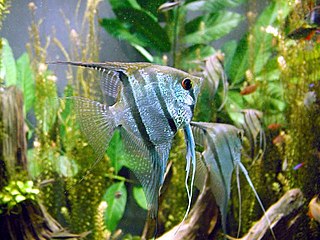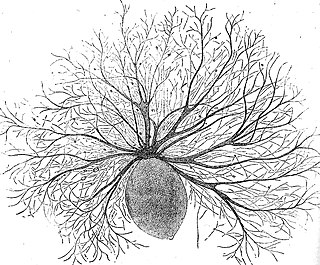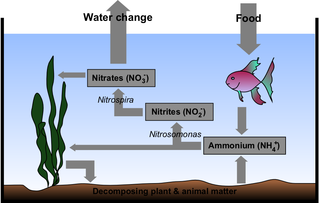
An infection is the invasion of tissues by pathogens, their multiplication, and the reaction of host tissues to the infectious agent and the toxins they produce. An infectious disease, also known as a transmissible disease or communicable disease, is an illness resulting from an infection.

Conjunctivitis, also known as pink eye, is inflammation of the outermost layer of the white part of the eye and the inner surface of the eyelid. It makes the eye appear pink or reddish. Pain, burning, scratchiness, or itchiness may occur. The affected eye may have increased tears or be "stuck shut" in the morning. Swelling of the white part of the eye may also occur. Itching is more common in cases due to allergies. Conjunctivitis can affect one or both eyes.

Mumps is a highly contagious viral disease caused by the mumps virus. Initial symptoms of mumps are non-specific and include fever, headache, malaise, muscle pain, and loss of appetite. These symptoms are usually followed by painful swelling around the side of the face, which is the most common symptom of a mumps infection. Symptoms typically occur 16 to 18 days after exposure to the virus. About one third of people with a mumps infection do not have any symptoms (asymptomatic).

Edema, also spelled oedema, and also known as fluid retention, dropsy, hydropsy and swelling, is the build-up of fluid in the body's tissue. Most commonly, the legs or arms are affected. Symptoms may include skin which feels tight, the area may feel heavy, and joint stiffness. Other symptoms depend on the underlying cause.

The neon tetra is a freshwater fish of the characin family of order Characiformes. The type species of its genus, it is native to blackwater and clearwater streams in the Amazon basin of South America. Its bright colouring makes the fish visible to conspecifics in the dark blackwater streams, and is also the main reason for its popularity among freshwater fish hobbyists, with neon tetras being one of the most widely kept tropical fish in the world.

Pterophyllum is a small genus of freshwater fish from the family Cichlidae known to most aquarists as angelfish. All Pterophyllum species originate from the Amazon Basin, Orinoco Basin and various rivers in the Guiana Shield in tropical South America. The three species of Pterophyllum are unusually shaped for cichlids being greatly laterally compressed, with round bodies and elongated triangular dorsal and anal fins. This body shape allows them to hide among roots and plants, often on a vertical surface. Naturally occurring angelfish are frequently striped transversely, colouration which provides additional camouflage. Angelfish are ambush predators and prey on small fish and macroinvertebrates. All Pterophyllum species form monogamous pairs. Eggs are generally laid on a submerged log or a flattened leaf. As is the case for other cichlids, brood care is highly developed.
Paratuberculosis is a contagious, chronic and sometimes fatal infection that primarily affects the small intestine of ruminants. It is caused by the bacterium Mycobacterium avium subspecies paratuberculosis. Infections normally affect ruminants, but have also been seen in a variety of nonruminant species, including rabbits, foxes, and birds. Horses, dogs, and nonhuman primates have been infected experimentally. Paratuberculosis is found worldwide, with some states in Australia being the only areas proven to be free of the disease. At least in Canada, the signs of BJD usually start when cattle are four to seven years of age, and then usually only are diagnosed in one animal at a time. Cattle "with signs of Johne’s disease shed billions of bacteria through their manure and serve as a major source of infection for future calves."
Fin rot is a symptom of disease or the actual disease in fish. This is a disease which is most often observed in aquaria and aquaculture, but can also occur in natural populations.

Velvet disease is a fish disease caused by dinoflagellate parasites of the genera Amyloodinium in marine fish, and Oodinium in freshwater fish. The disease gives infected organisms a dusty, brownish-gold color. The disease occurs most commonly in tropical fish, and to a lesser extent, marine aquaria. Periodic use of preventive treatments like aquarium salt can further deter parasites. Regular monitoring, attentive care, and preventive measures collectively contribute to keeping fish healthy and velvet-free.

Gingivostomatitis is a combination of gingivitis and stomatitis, or an inflammation of the oral mucosa and gingiva. Herpetic gingivostomatitis is often the initial presentation during the first ("primary") herpes simplex infection. It is of greater severity than herpes labialis which is often the subsequent presentations. Primary herpetic gingivostomatitis is the most common viral infection of the mouth.

The schedule for childhood immunizations in the United States is published by the Centers for Disease Control and Prevention (CDC). The vaccination schedule is broken down by age: birth to six years of age, seven to eighteen, and adults nineteen and older. Childhood immunizations are key in preventing diseases with epidemic potential.

Sialadenitis (sialoadenitis) is inflammation of salivary glands, usually the major ones, the most common being the parotid gland, followed by submandibular and sublingual glands. It should not be confused with sialadenosis (sialosis) which is a non-inflammatory enlargement of the major salivary glands.

Ornamental fish kept in aquariums are susceptible to numerous diseases. Due to their generally small size and the low cost of replacing diseased or dead fish, the cost of testing and treating diseases is often seen as more trouble than the value of the fish.
Pseudomonas oryzihabitans is a nonfermenting yellow-pigmented, gram-negative, rod-shaped bacterium that can cause sepsis, peritonitis, endophthalmitis, and bacteremia. It is an opportunistic pathogen of humans and warm-blooded animals that is commonly found in several environmental sources, from soil to rice paddies. They can be distinguished from other nonfermenters by their negative oxidase reaction and aerobic character. This organism can infect individuals that have major illnesses, including those undergoing surgery or with catheters in their body. Based on the 16S RNA analysis, these bacteria have been placed in the Pseudomonas putida group.

Columnaris (also referred to as cottonmouth) is a symptom of disease in fish which results from an infection caused by the Gram-negative, aerobic, rod-shaped bacterium Flavobacterium columnare. It was previously known as Bacillus columnaris, Chondrococcus columnaris, Cytophaga columnaris and Flexibacter columnaris. The bacteria are ubiquitous in fresh water, and cultured fish reared in ponds or raceways are the primary concern – with disease most prevalent in air temperatures above 12–14 °C. It is often mistaken for a fungal infection. The disease is highly contagious and the outcome is often fatal. It is not zoonotic.

A staphylococcal infection or staph infection is an infection caused by members of the Staphylococcus genus of bacteria.
Gastroenterocolitis is a condition characterized by inflammation of the stomach, small intestines, and colon.

Meningitis is acute or chronic inflammation of the protective membranes covering the brain and spinal cord, collectively called the meninges. The most common symptoms are fever, intense headache, vomiting and neck stiffness and occasionally photophobia.

Swim bladder disease, also called swim bladder disorder or flipover, is a common ailment in aquarium fish. The swim bladder is an internal gas-filled organ that contributes to the ability of a fish to control its buoyancy, and thus to stay at the current water depth without having to waste energy in swimming. A fish with swim bladder disorder can float nose down tail up, or can float to the top or sink to the bottom of the aquarium.

A feline zoonosis is a viral, bacterial, fungal, protozoan, nematode or arthropod infection that can be transmitted to humans from the domesticated cat, Felis catus. Some of these diseases are reemerging and newly emerging infections or infestations caused by zoonotic pathogens transmitted by cats. In some instances, the cat can display symptoms of infection and sometimes the cat remains asymptomatic. There can be serious illnesses and clinical manifestations in people who become infected. This is dependent on the immune status and age of the person. Those who live in close association with cats are more prone to these infections, but those that do not keep cats as pets can also acquire these infections as the transmission can be from cat feces and the parasites that leave their bodies.

















